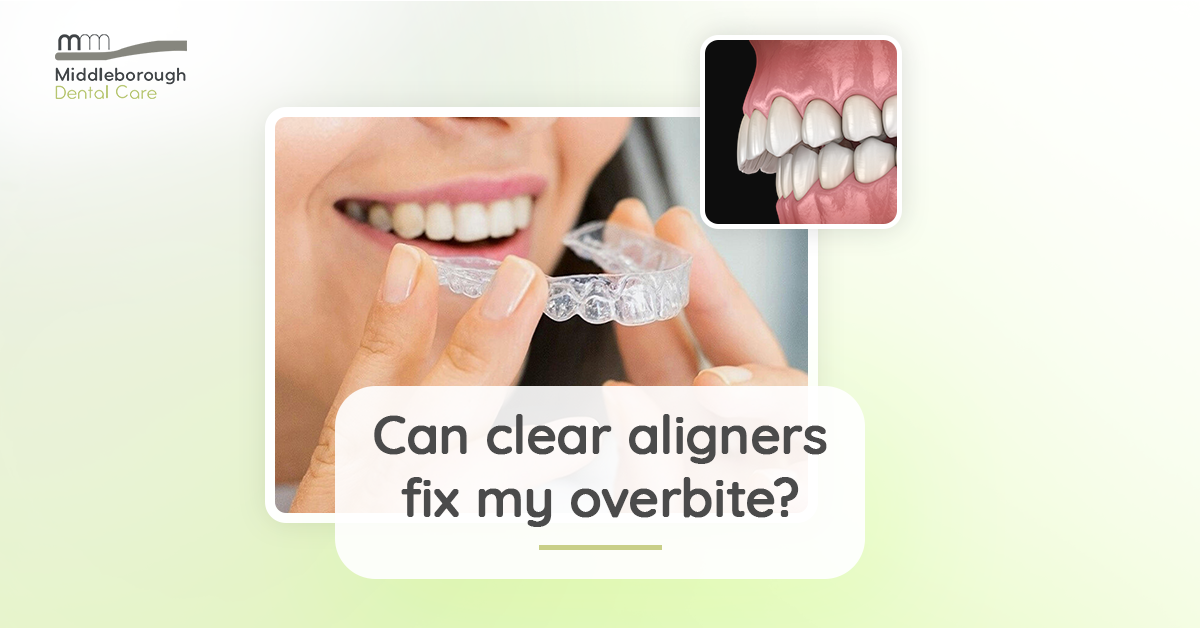
Can clear aligners fix my overbite?
While clear aligners were an extremely effective treatment when they were first approved for use in the late 1990s, they’ve come a long way in the 25-plus years since.
Further development of the technology and techniques has been helped by the fact that the dental community (including the clear aligner manufacturers) have had data from millions and millions of patients informing best practices and proving what works.
As a result, we can give a straightforward answer to the question: Can clear aligners fix my overbite?
Yes, clear aligners can fix an overbite … and have done so successfully for many people.
Importantly, age plays a role in your mouth and jaw’s capacity to adapt, so addressing an overbite sooner rather than later may shorten the length of treatment.
What is an overbite?
As we often note, no two ‘mouthfuls’ of teeth are the same. Every set of teeth we see has its own unique combination of sizes, shapes, alignment and spacing, while the shape and alignment of a person’s upper and lower jawbones also play a part.
When the top teeth significantly overlap the bottom teeth, we refer to that as an overbite.
You might not realise that most people have a small degree of overbite, with their upper teeth protruding over their bottom teeth by 2 to 4mm. Most of us aren’t concerned or impacted by this minor degree of overbite.
However, more severe overbites, where the top teeth jut over the bottom teeth by more than 4mm, can affect appearance, clarity of speech, and the ability to chew food and, therefore, should be corrected.
There are two types of overbite
A horizontal overbite, also known as an overjet, is when the upper teeth protrude too far forward over the bottom teeth. This can occur if the upper teeth are angled forward in the mouth or if the upper jaw is significantly forward of the lower jaw.
A vertical overbite is one where the upper teeth extend down over the bottom teeth.
While some overhang of the top teeth is normal, when the top teeth hang down significantly over the bottom teeth, there is a greater chance of chipping, cracking, and excessive wear of the front teeth.
How clear aligners fix an overbite
In much the same way as clear aligners work to straighten teeth and close gaps between them, aligners fix overbites by applying constant, gentle pressure on the teeth over time.
The pressure gradually ‘encourages’ teeth to realign until they are in their optimal locations and ideal alignments.
With children up to about 12 years of age, who are still growing, an overbite can generally be corrected in conjunction with their growth.
Because it’s a gradual process of correction, it doesn’t happen in a short time, and it requires full commitment from the patient. Aligners must be worn for at least 22 hours a day, including overnight while you’re asleep. They should be removed for eating, brushing and flossing only.
Each patient receives a set of aligning trays, each to be worn for about two weeks. Each tray in the sequence is precisely designed to move the teeth a certain amount before you move to the next tray for the next fortnight.
Typically the entire process can involve as many as 26 trays, or one every two weeks for 12 months.
Why are clear aligners a popular treatment option?
Perhaps the most obvious reason that clear aligners have become such a popular treatment is the fact that the trays are virtually invisible.
The other notable advantage is that the trays are removable. Because they can be taken out when you’re eating, there are no dietary restrictions as food won’t get stuck or potentially do any damage to the tray.
Similarly, being able to brush and floss freely with the tray out means that your oral hygiene process doesn’t involve any extra steps.
Additionally, clear aligner treatment usually takes less time than treatment with traditional braces. Most people complete their treatment within nine to 12 months.
All of these advantages combine to help make clear aligner treatment significantly more cost-effective than some other treatments, and particularly where a combination of treatments might otherwise be recommended.
Not all overbites are suitable for clear aligner treatment
The Middleborough Dental Care team will be able to assess whether your overbite can be treated with clear aligners.
In some cases, where the overbite is more significant (or has a skeletal component), we might recommend braces, surgery, and/or an extraction.
Braces are typically recommended when more pressure will be needed to move the teeth than clear aligners would be able to exert.
An extraction could be an option where the teeth would not otherwise have enough room to move.
Surgery would only be considered where moving the teeth alone won’t fix the overbite and the jawbone itself needs some realignment. Surgery is typically recommended for adults as it’s usually possible to guide the growth of a child’s jaw before a skeletal overbite develops.
Let the MDC team make an assessment
Once we have a look at your teeth we can advise you about a personalised treatment plan.
Treatment for children is different to that for teens and adults because it’s usually easier to redirect and guide tooth and even jaw development while the patient is still growing.
As with all proposed treatments at Middleborough Dental Care, we will take the time to explain the process in full, as well as any considerations you should understand before going ahead with treatment.
We want you to feel totally comfortable with what we’re going to do, even when it’s something like clear aligner treatment that has been tried and tested over many years with numerous patients.
After all, there’s only one you and your oral health and overall wellbeing are the priority.